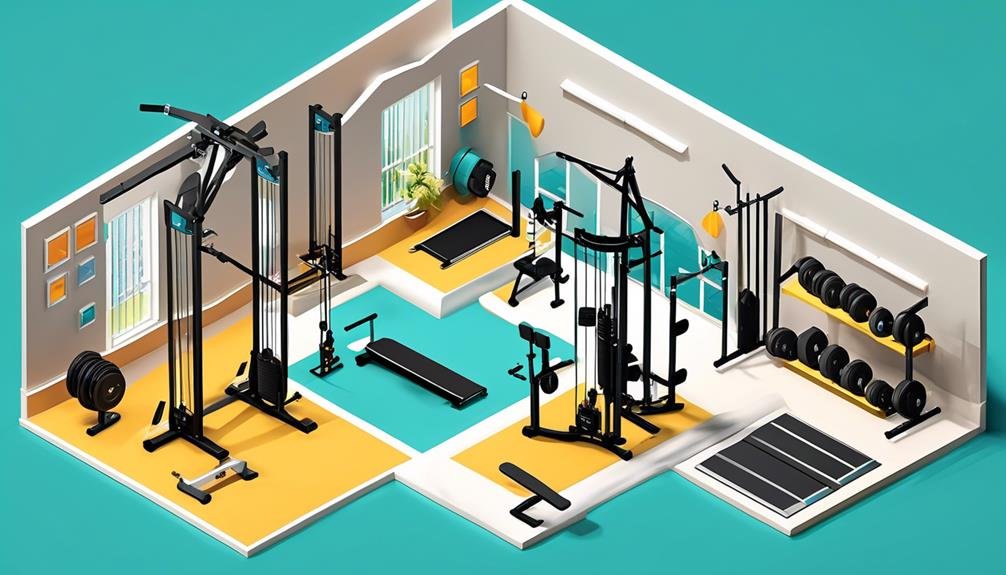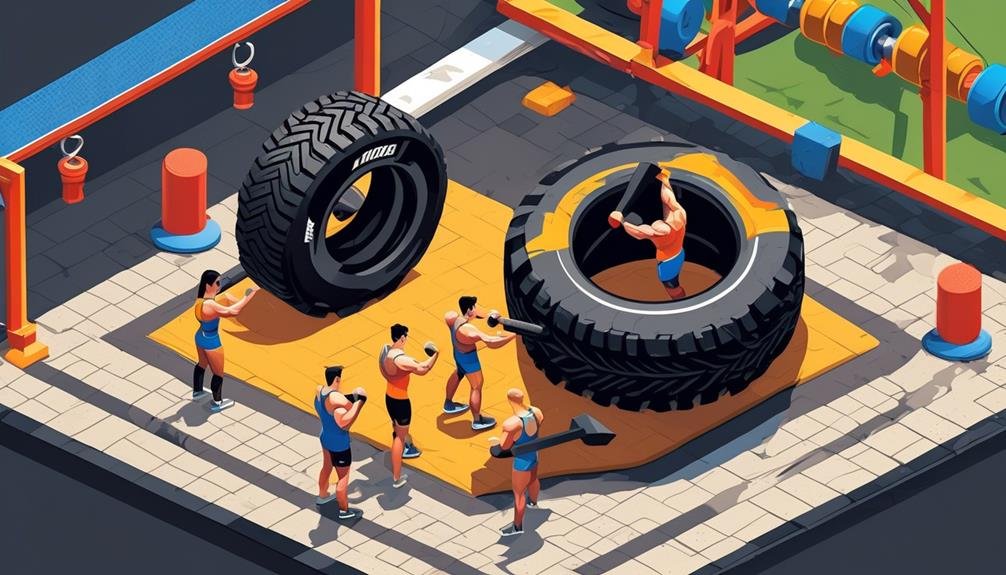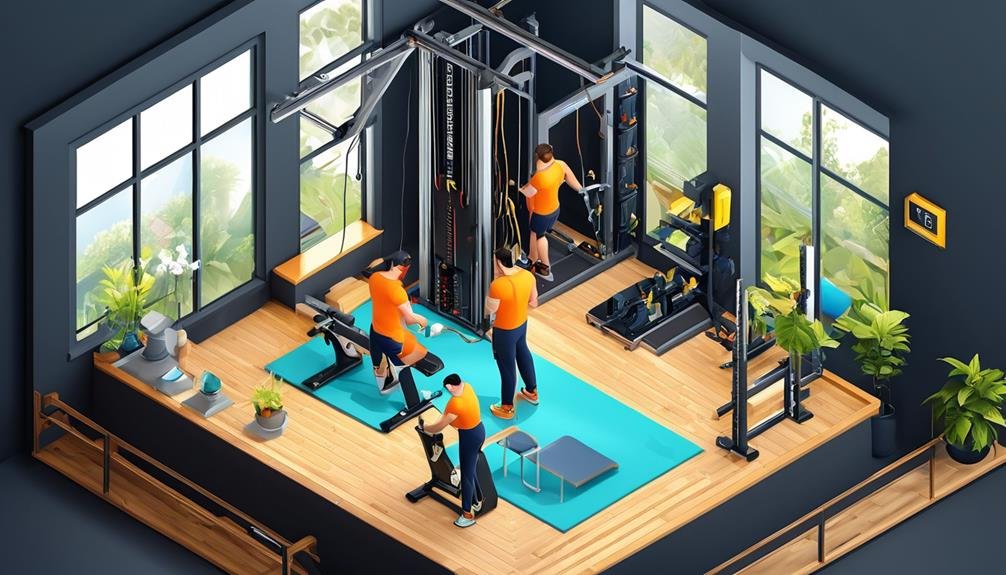Disclaimer: This content is for informational purposes only and does not replace professional medical advice, diagnosis, or treatment. Always consult a qualified healthcare provider before beginning any new exercise program.
Imagine stepping into a fitness center, the hum of machines filling the air as you survey rows of treadmills and exercise bikes. Each one promises to be the key to your fitness goals, but how do you choose?
In this discussion, we will explore the pros and cons of different types of treadmills and exercise bikes, allowing you to make an informed decision on which machine will best suit your needs.
From the impact on your joints to the muscles worked, and even the adjustability and customization options, we will delve into the details, guiding you towards the perfect fit for your fitness journey.
Key Takeaways
- Treadmills take up more space and are heavier to move compared to exercise bikes, making exercise bikes a more space-efficient and portable option.
- Exercise bikes provide a low-impact cardio workout that's gentle on joints, making them suitable for individuals with joint issues or existing joint pain.
- Treadmills are ideal for high-intensity workouts like interval training or high-speed runs, while exercise bikes offer lower-impact workouts and allow for easy adjustment of workout intensity.
- Both treadmills and exercise bikes can help burn calories and contribute to overall fat loss, but the specific calorie burn and muscle engagement may vary based on the chosen equipment.
Size Considerations
When considering the size of exercise equipment for your home, it's important to take into account the space available and the ease of moving and storing the equipment. This is especially true when deciding between a treadmill and an exercise bike for your home workout space.
Treadmills generally take up more space and are heavier to move compared to exercise bikes. This makes treadmills less suitable for small living spaces or areas with limited room. On the other hand, exercise bikes, particularly recumbent bikes, tend to have a smaller footprint and are more space-efficient than treadmills. They're a great option for those who've limited space or prefer a compact cardio equipment.
When selecting a treadmill or exercise bike, it's important to ensure that it fits comfortably in your designated workout area, taking into consideration your body size and any space constraints. If you have limited space, you may want to consider compact and foldable treadmill models or upright exercise bikes, which can be easily stored when not in use.
Impact on Joints
Exercise bikes and treadmills have different impacts on joints, and understanding these differences can help you make an informed decision about which equipment is best for your fitness goals.
Here are three key points to consider:
- Low-impact activity: If you have joint issues or are concerned about putting stress on your joints, an exercise bike is a great option. The pedaling motion of a stationary bike provides a low-impact cardio workout that's gentle on your joints. It allows you to burn calories and work various muscle groups without subjecting your joints to excessive pressure.
- Simulating walking or running: Treadmills simulate the experience of walking or running, which can be beneficial for individuals without walking problems. However, this type of exercise equipment tends to put more pressure on your joints, especially your ankles, knees, hips, and spine. If you have any existing joint issues or are prone to joint pain, you may want to consider the potential impact before choosing a treadmill.
- Considering intensity and duration: Both exercise bikes and treadmills can be effective for weight loss and improving cardiovascular fitness. However, the intensity and duration of your workouts can also affect the impact on your joints. With an exercise bike, you have more control over the intensity by adjusting resistance levels. On a treadmill, the impact on your joints can increase with higher speeds or longer durations. It's important to find a balance that challenges you without causing excessive strain on your joints.
Time Efficiency

If you're looking to maximize your workout time, considering the time efficiency of treadmills and exercise bikes is essential. Both machines offer effective ways to burn calories and engage in cardiovascular exercise, but their approaches differ. Let's take a closer look at the pros and cons of each when it comes to time efficiency:
| Treadmills | Exercise Bikes |
|---|---|
| Pros: | Pros: |
| – Ideal for high-intensity workouts like interval training or high-speed runs. | – Allows for lower-impact workouts, reducing the risk of joint pain or injury. |
| – Offers weight-bearing exercise, which can help strengthen bones and muscles. | – Easy to vary intensity levels, making it simple to adjust the workout according to time constraints. |
| Cons: | Cons: |
| – May require more time to warm up and cool down due to higher impact on joints. | – May not provide the same level of calorie burn as high-intensity treadmill workouts. |
| – The risk of injury may increase if not used with proper form and caution. | – Limited options for incline and terrain simulation, potentially leading to a less varied workout. |
Both treadmills and exercise bikes can provide time-efficient workouts when used effectively and consistently. For those looking for high-intensity workouts or interval training, treadmills may be the preferred option. On the other hand, exercise bikes offer a lower-impact alternative that can be more suitable for individuals with joint pain or a higher risk of injury. Ultimately, the choice between the two will depend on your specific goals, preferences, and time availability.
Logistics and Portability
For individuals seeking fitness equipment that's easy to transport and store, exercise bikes offer a more convenient option compared to treadmills. Here are three reasons why exercise bikes are a more suitable choice when considering the logistics and portability of fitness equipment:
- Compact Size: Exercise bikes are generally more compact than treadmills, making them easier to move and store in smaller spaces. They've a smaller footprint and can be easily tucked away in a corner or closet when not in use. This is especially beneficial for those living in apartments or homes with limited space.
- Lightweight: Exercise bikes are lighter in weight compared to treadmills, making them easier to transport. Whether you need to move it from room to room or take it with you on a trip, the lightweight design of exercise bikes allows for effortless maneuverability. Some models even come with wheels for added convenience.
- Versatility: Exercise bikes offer a wide range of options when it comes to portability. There are folding exercise bikes that can be easily collapsed and stored away, as well as portable models that can be taken apart and reassembled without much hassle. This flexibility allows you to take your exercise bike wherever you go, ensuring you never miss a workout.
Upright Vs. Recumbent Bike
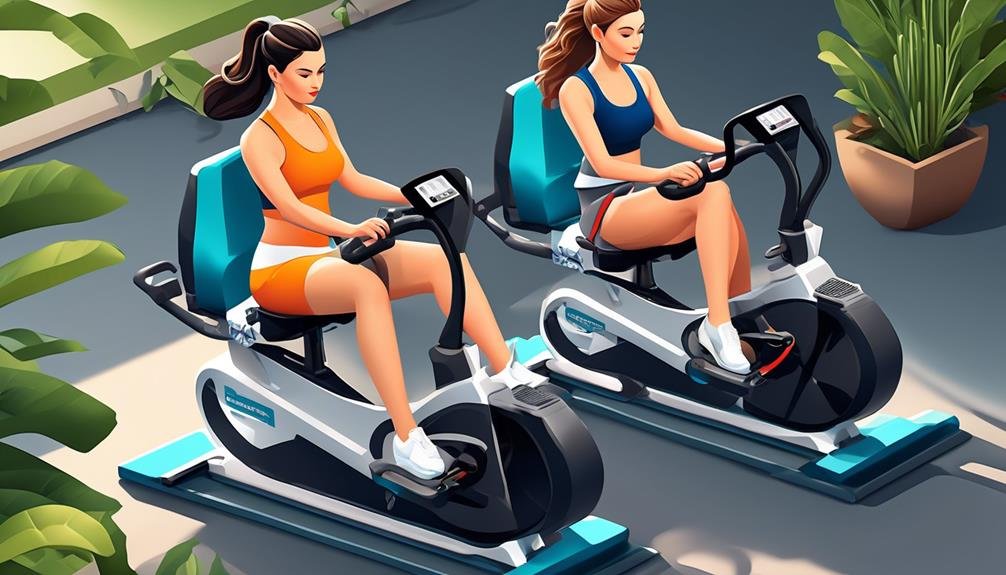
When considering the choice between an upright and recumbent bike, it's important to understand the differences and benefits each option offers.
Upright exercise bikes are designed to mimic outdoor cycling, focusing on working out the legs, especially the quadriceps. These bikes don't provide back support and are ideal for warming up, cooling down, and cardio workouts.
On the other hand, recumbent bikes offer back support and are more comfortable, making them a suitable choice for individuals with balance issues or lower back problems.
The difficulty and intensity of your workout on either type of bike depend on the settings you choose. For example, a vigorous high-intensity interval training (HIIT) workout on a spin bike can be more intense than walking on a treadmill. However, it's important to note that the heart rate tends to be higher on a treadmill compared to an exercise bike.
Both upright and recumbent bikes provide an effective means of cardio exercise, helping you burn calories and improve your fitness. The number of calories burned per workout varies based on factors such as your weight and the intensity of your exercise.
Workout Difficulty
The difficulty and intensity of your workout on a treadmill or exercise bike will depend on the settings you choose and the type of exercise you prefer. Here are three key points to consider when comparing the workout difficulty of treadmills and exercise bikes:
- Calorie Burn:
Treadmills generally burn more calories than stationary bikes. Running or walking on a treadmill engages major muscles of the body, resulting in a higher calorie burn compared to cycling. The exact number of calories you burn depends on factors such as your weight, speed, and incline.
- Joint-Friendly Option:
Exercise bikes can be a good option for people who struggle with joint issues. Cycling is a low-impact exercise that puts less stress on the joints compared to running or walking on a treadmill. This makes it a suitable choice for individuals with knee, hip, or ankle problems.
- Targeting Belly Fat:
If your goal is to burn belly fat, both the treadmill and stationary bike can help. While running or walking on a treadmill engages the core muscles and can contribute to overall fat loss, cycling primarily focuses on the lower body. However, combining regular cardio exercise with strength training and a healthy diet is essential for effective belly fat reduction.
Ultimately, the best option for you'll depend on your fitness goals, preferences, and any physical limitations you may have. Both treadmills and exercise bikes are effective exercise machines that can help you achieve your health and fitness goals.
Muscles Worked
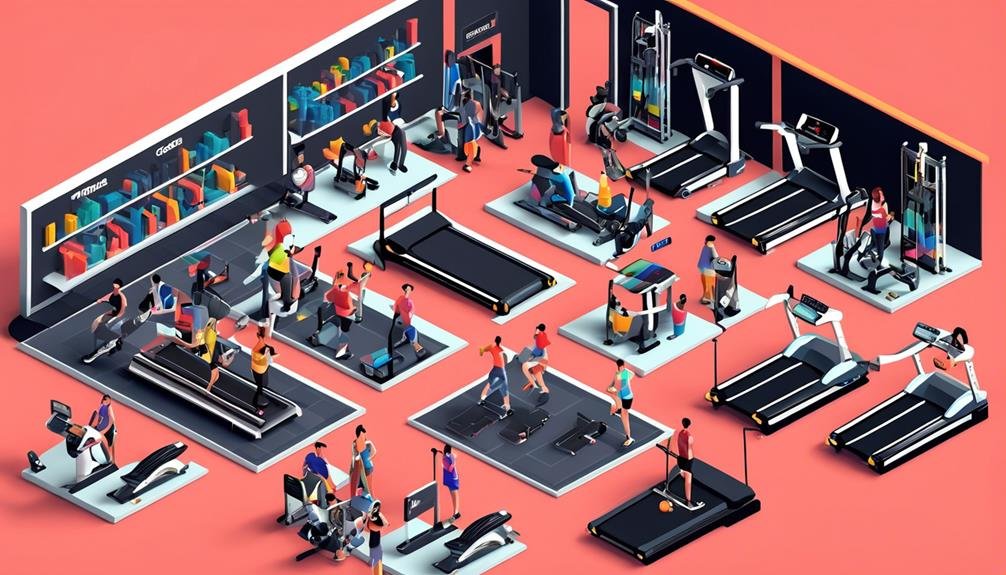
Stationary bikes and treadmills target different muscle groups, providing a comprehensive workout for your lower body, core, and even upper body depending on the machine you choose. When it comes to exercise bikes, the main muscles worked are the quadriceps, hamstrings, calves, and glutes. These muscles are engaged as you pedal against resistance. If you're using a spin bike, you can also engage your shoulders, core, and back muscles by standing on the pedals and incorporating upper body movements.
On the other hand, treadmills primarily focus on the lower body muscles. Walking and running engage the muscles in your legs, such as the quadriceps, hamstrings, calves, and glutes. By increasing the incline on the treadmill, you can target your calves, glutes, and hamstrings even more. Additionally, when you swing your arms while walking or running, you can also engage your upper body muscles, including your arms and core.
Both stationary bikes and treadmills offer the opportunity for cardio workouts and can be used for interval training or HIIT training. However, it's important to note that stationary cycling is generally considered lower impact compared to running on a treadmill, which may be beneficial for those with joint issues or injuries.
Adjustability and Customization
For a customizable and comfortable workout experience, both exercise bikes and treadmills offer a range of adjustments to suit your needs. Here are three ways in which these pieces of equipment can be adjusted and customized:
- Seat and handlebar adjustments: Exercise bikes allow you to adjust the seat height and handlebar height to ensure proper alignment and comfort during your workout. Some indoor cycles even offer additional adjustments, such as seat and handlebar positions, allowing you to find the perfect fit for your body.
- Resistance and incline settings: Treadmills provide the option to adjust both speed and incline. By increasing the incline, you can simulate running uphill and engage different muscle groups. Adjusting the resistance on exercise bikes allows you to vary the intensity of your workout, challenging yourself as your fitness level improves.
- Customized workout intensity: The adjustability of both treadmills and exercise bikes allows you to customize the intensity of your workout. Whether you prefer a high-intensity interval training session or a steady-state cardio workout, you can easily modify the settings to suit your fitness goals.
The benefits associated with adjustability and customization include improved comfort, reduced risk of injury, and the ability to progress and challenge yourself as you become fitter. However, it's important to consider the potential drawbacks as well. Some basic models of treadmills may not have incline settings, limiting your workout options. Additionally, adjusting the settings during your workout can be time-consuming and disrupt the flow of your exercise session.
Frequently Asked Questions
Which Is Better Exercise a Stationary Bike or Treadmill?
If you're looking for a low-impact workout, a stationary bike might be better for you. However, if you want a higher calorie burn and a full-body workout, a treadmill could be the way to go.
What Are the Pros and Cons of Using a Treadmill Rather Than a Bike for Training and Testing?
Using a treadmill for training and testing has pros and cons. Pros include a full-body workout and a higher calorie burn rate. Cons include the higher cost and space requirements compared to a bike.
What Are the Pros and Cons of a Treadmill?
Treadmills offer a full-body workout and adjustable intensity, but they come with a higher risk of injury and are bulkier and noisier compared to exercise bikes.
What Are the Pros and Cons of a Stationary Bike?
Stationary bikes offer low-impact workouts, ideal for those with joint issues or injuries. They're cost-effective and space-saving. However, they might not engage muscles or burn calories as much as treadmills. Different types provide varying back support and work different leg muscles. Customization options ensure a comfortable workout.
Conclusion
In conclusion, when considering different types of treadmills and exercise bikes, it's important to weigh the pros and cons.
Treadmills offer a wide range of workout options and higher calorie burn, but come with the risk of injury and require more space.
Exercise bikes provide low-impact workouts and are suitable for individuals with joint issues, but may not offer as many workout variations.
Ultimately, the choice between treadmills and exercise bikes depends on individual preferences, fitness goals, and physical limitations.

